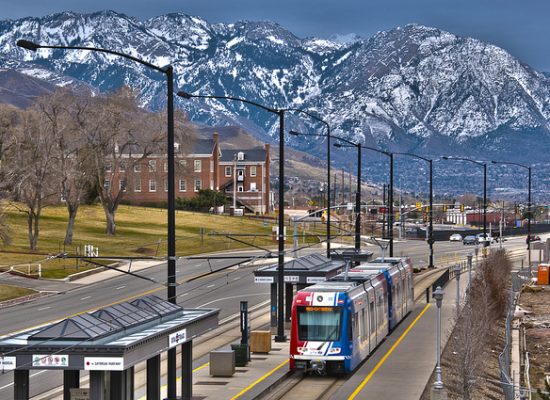

TransitCenter was in the Beehive state for the 2015 APTA Rail Conference that brought together planners, engineers, and operators from across the country to experience first hand the investments Utahans have made.
A quiet has settled over the Salt Lake Valley. For the first time since 2000, no new light rail, streetcar or commuter rail extensions are underway. Salt Lake City and its transit agency, the Utah Transit Authority, have built more miles of rail transit than any other region in that time. With a visionary board and capable staff, constructing and delivering projects became a part of the UTA’s culture. The next expansion needed is to service and ridership, a challenge that will require new connections among transit leaders and advocates.
The Wasatch Front has been a model for other regions of how to raise funds and create political, business, and community support for transit expansion in a conservative context. That unity was borne out of hosting the 2002 Winter Olympics and thanks to a common vision of growth that emerged from Envision Utah’s social values planning in the late 1990’s. By surveying tens of thousands of Utahans Envision Utah pulled out the region’s common values to shape a vision for growth, one defined by tightly knit communities connected by affordable transit.
Those common values underpin the region’s strong transit use, with 25 percent of downtown employees and 37 percent of University of Utah staff and faculty riding transit every day. Yet when the desire for more rail to more places met the fiscal constraints of the Great Recession, service on buses was sharply curtailed, especially on nights and weekends. While rail ridership has increased 28 percent since 2011 thanks to expansions of the red, green and blue lines, bus ridership has plummeted 13 percent and highlights a major opportunity for investment in the region. A frequent, legible bus network that spans beyond just peak hours on the weekday is a need the UTA has identified and must be a top priority for the region if wants to grow the tightly knit affordable communities Utahan’s value.
If the region can make that transition from expansion to improving service, can it once again be a model for other regions? While in Salt Lake City for the 2015 APTA Rail Conference, the TransitCenter delegation also got to meet with two young organizations who are raising their voices and shaping the future of transit in the region.
At the grasstops is the Utah Transportation Coalition made up of the Chamber of Commerce, the Utah League of Cities and Towns, and the Utah Association of Counties. The coalition is focused on gaining the counties’ support to authorize a ballot initiative for transportation funding, 40 percent of which would go to UTA and be prioritized for service and maintenance. This would be the region’s first ballot measure without transit expansion, leading to concern in the region about whether it could pass.
At the grassroots is the Utah Transit Riders Union. Started in 2013, the organization works to build support transit, improve bus service and ensure that the UTA is using its resources equitably. The 700 member organization with no paid staff has plenty of potential and has a challenge in creating a grassroots movement around transit where nine out of ten households own a car.
Investing in an improved transit service in off peak hours and a legible bus system is key to making Salt Lake a region that can support the walkable, mixed used neighborhoods that Americans want. To make that vision a reality, it’s going to take these two groups learning from those in the region like Envision Utah who have been so adept at bringing together residents through shared values. If they can rally political leaders, advocates, and UTA staff to make some noise for better transit service, Salt Lake City will continue to be a model for cities across the country.
CORRECTION: The original version of this post misstated the founding date of the Utah Transit Riders Union. It was founded in September 2013.

Till next time Salt Lake!
 On the Brink: Will WMATA’s Progress Be Erased by 2024?
On the Brink: Will WMATA’s Progress Be Erased by 2024?
The experience of being a WMATA rider has substantially improved over the last 18 months, thanks to changes the agency has made like adding off-peak service and simplifying fares. Things are about to get even better with the launch of all-door boarding later this fall, overnight bus service on some lines starting in December, and an ambitious plan to redesign the Metrobus network. But all of this could go away by July 1, 2024.
Read More A Bus Agenda for New York City Mayor Eric Adams
A Bus Agenda for New York City Mayor Eric Adams
To create the “state-of-the-art bus transit system” of his campaign platform, Mayor Adams will have to both expand the quantity and improve the quality of bus lanes. We recommend these strategies to get it done.
Read More